It’s a sad day when you notice your black t-shirt is starting to look a little faded, and you decide it might be time to part ways.
But what if there was a way of breathing new life back into your old, faithful top? What if you could restore it to its original colour?
Restoring a garment is much easier than you think. You just need to dye the item black again and it will be as good as new!
Not sure how to restore faded black clothes? You’re in the right place. Everything you need to know about recolouring your black laundry is listed below.
Why Do Black Clothes Fade?

Black items of clothing fade for multiple reasons, these are the most common ones:
- General wear and tear
- Items get washed too much
- Black clothes are washed with light clothes
- Agitation and friction in the washing machine causes fading
- Laundry is washed in too much detergent
Generally, the more you wear an item, the more movement and friction the material is going to be exposed to. And this, in turn, is going to cause the colour to fade.
Likewise, the more you wash a piece of black clothing, the more faded it will become because the continuous washing and agitation it is exposed to in the machine will slowly erode the colour.
And although it’s not nice to see your black clothes fade, it is actually something that happens and you can’t really stop it. You can only slow down the process and repair your clothes when you need to.
How to Restore Faded Black Clothes
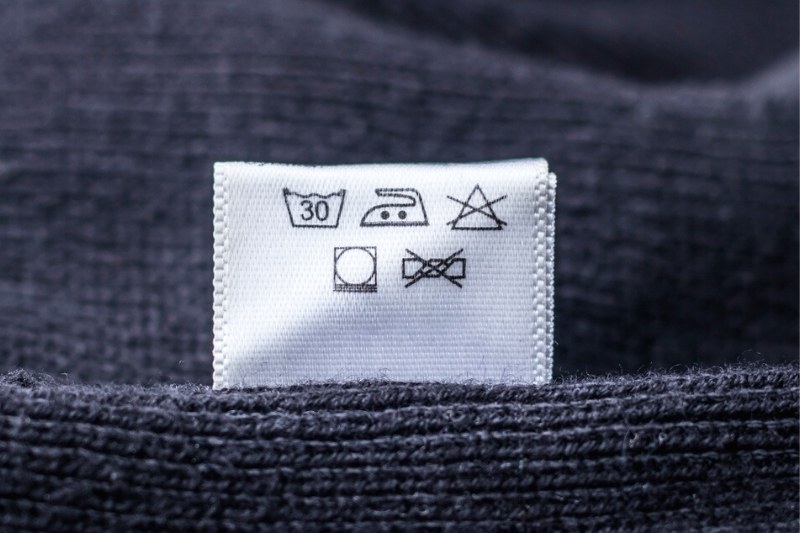
If your black jeans are looking a tad worse for wear, or your favourite shirt is getting greyer every day, you need to bring back the colour to these items!
And you can revive these faded black clothes by dyeing them. Check out the methods below to restore faded black clothes.
Before you start dyeing your clothes you should…
- Pre-treat stains before dyeing your clothes – The dyeing procedure may lock in marks on clothes.
- Do a patch test if you’re not sure if the material will take the dye.
- Read your clothes’ tags before starting, as this will iron out any last-minute concerns you have.
- After completing the dyeing procedure, you should air dry your clothes, preferably on the line outside.
- After you’ve started to wear your freshly dyed black clothes, you will need to keep on washing them in cold water, so the fabric keeps hold of the dye.
- Try to use bleach-free detergents wherever possible.
- Use liquid detergent because powdered detergent can leave residue on clothes.
To dye or not to dye?
What materials can be dyed?
Typically, the more natural the material you’re working with is, the easier it is to dye. The fibres react well to the dye, and if you carry out the process correctly, you should end up with an evenly dyed garment. The exception to this is nylon, which is a synthetic material but can be dyed.
Materials that can be dyed effectively at home, include:
- Linen
- Cotton
- Silk
- Wool
- Rayon
- Nylon
What materials cannot be dyed?
It’s easy to assume that all clothes can be dyed because clothes are usually colourful. But this isn’t strictly the case.
A lot of materials can’t be dyed properly at home. And if the fabrics in question are dyed, they don’t always change colour uniformly, so they end up patchy. Or they just don’t take on the new dye at all.
Materials that cannot be dyed effectively at home, include:
- Polyester
- Lycra
- Acrylic
You should also avoid dyeing items that are labelled as “dry clean only”.
Can mixed materials be dyed?
If an item of clothing is made up of 100% natural fibres, it can be dyed with ease.
If an item of clothing is made from a blend of natural and synthetic fibres, the clothes will react well to the dye, as long as the natural fibres make up most of the blend – 60% or more.
If the item is more synthetic fibre than natural, the garment may not react very well to the dye. The item might look darker in parts and you might not end up with the desired end result. The exception to this is nylon, which synthetic but can still be dyed.
Method 1: Dye black clothes in a bucket to restore their colour
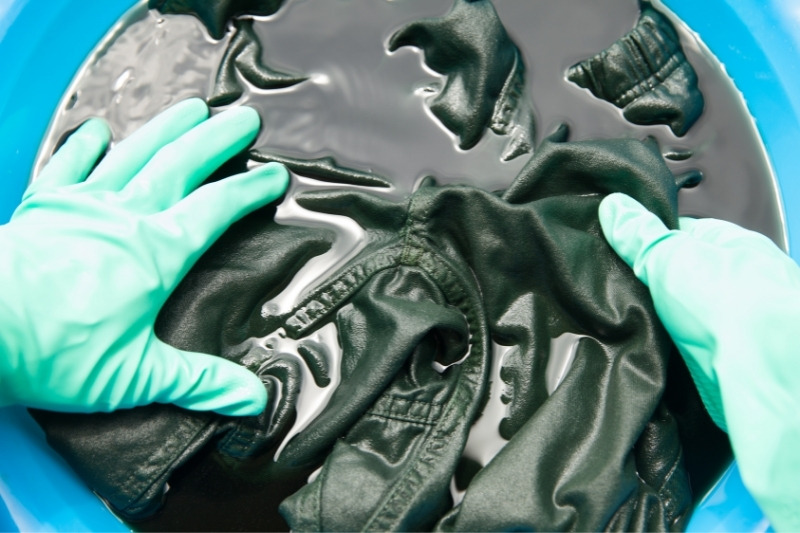
Below you’ll find a series of steps to follow to dye your clothes with an actual clothes dye. Try not to skip any sections out as you go!
Step 1: Read the clothes tag and decide if the material can be dyed
Before you start dyeing your clothes you should check what material your item is made from.
Based on this information, you’ll either be able to continue with the method below. Or you’ll be able to save yourself time and money because the process isn’t going to work out for your clothes.
Check the list above to see if your material can be dyed.
Step 2: Prepare your laundry and tools for the dyeing process
One of the key steps when dyeing any type of garment is preparing your workspace and your tools.
Dyeing can be messy work, so the last thing you want is to be traipsing around your house carrying dye everywhere!
- Make sure you have a clean and clear workspace.
- Cover the floors/surfaces with newspaper, so if you do spill dye, the paper will catch it.
- Read the instructions on your dye pack.
- Put your tools in an easy to reach space – buckets, gloves and mask, for example.
- You will not be able to use your bathtub because the dye will mark it – stick to plastic bucket/large tubs, stainless steel sinks or big stainless-steel pans.
- Complete a final check to make sure you have everything you need – use the checklist below to help you.
Checklist:
- Tubs/buckets where you can do the dyeing
- Covered surfaces
- Protection
- A dye kit
- Access to hot and cold water
- Faded black items
- Stirring device
Step 3: Start the dyeing process
Tip: Make sure you actually use enough dye for the number of items you’re going to dye. (This information will be on the dye’s packaging).
- Fill a tub/bucket up with boiling hot water.
- Add the item you want to dye to this water.
- Leave it to rest in the water for a few minutes before officially starting the dyeing process – this helps to soften up the material’s fibres.
- Fill another tub/bucket up with boiling hot water – the hotter the water the better the end result will be.
- Make sure there’s enough boiling water in the tub/bucket.
- Prepare your dye according to the instructions on the packaging.
- Add the dye to the boiling hot water.
- Stir the dye into the boiling water – make sure all the water changes colour.
- Put the item you want to dye black into the water.
- Make sure the garment is completely submerged in the water.
- Move the item about in the water regularly, so the dye has a chance to cover the entire piece.
- Leave the garment in the water for the length of time stipulated on the dye box’s packaging.
- It’s important that you maintain the water’s temperature through this process, so add hot water as and when you need to. Or if you’re using a stainless-steel pan, perhaps you could pop the pan on the hob to boil.
- Pull the item out of the water and rinse it under warm water for a minute or two.
- Continue to rinse the item but in cold water afterwards.
- You will have to continue to rinse the garment until the water runs clear.
- Once you’re done and the water is clear, turn the item inside out and put it in the washing machine.
- Wash the item alone on a gentle, cold setting in the washing machine – use a mild detergent.
Optional: To intensify the dyeing process some people add a tablespoon of non-bio laundry detergent to the water. When dyeing cotton, linen and rayon, add a cup of table salt to the water to intensify the dyeing process. When dyeing silk nylon and wool, add a cup of white vinegar to the water to intensify the dyeing process.
Step 4: Drying your dyed black clothes
It’s much better for your newly dyed laundry to be dried on the line outside. However, if you don’t have access to a line but you have a tumble dryer, you can also dry the items this way.
Just make sure to pick the shortest cycle, the gentles cycle and stick to a cool-warm heat setting.
Method 2: Use coffee to restore your faded black clothes
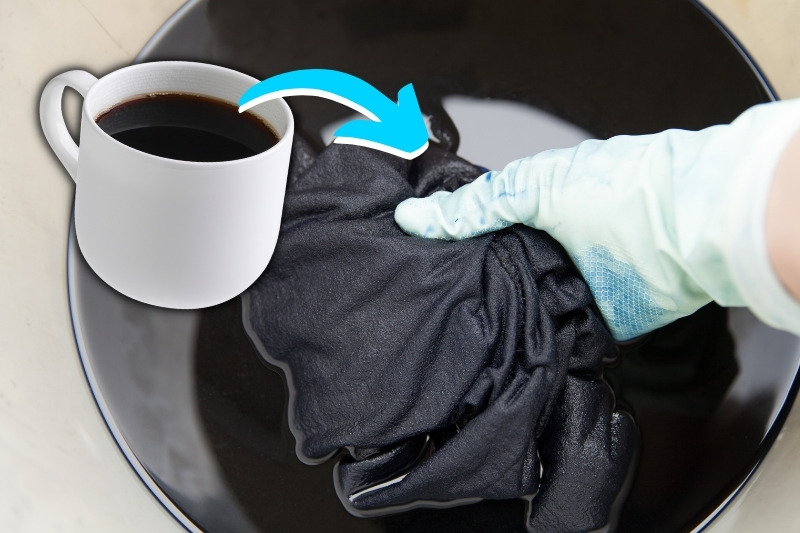
If you’d prefer to try something a little different, you can go down the coffee route! Although, do keep in mind that coffee isn’t likely to work as well as actual dye. But it’s worth a go if your clothes have only faded a little!
Coffee, believe it or not, has an uncanny ability to enhance black dye in clothes but in a very subtle and gentle way. To understand what effect it may have, take a look at your stained coffee mug to see how it’s marked the material.
So, with this in mind, let’s start dyeing faded black clothing.
Steps to follow:
- First of all, make sure the material you want to dye can actually be dyed – see the list of material above for more information.
- Fill a large bucket up halfway with boiling hot water.
- Boil the kettle and make several cups of strong, black coffee – don’t add sugar and milk!
- Put your faded black item in the water while the kettle is boiling – the hot water will soften the item up.
- Pour the cups of coffee you’ve just made into the bucket.
- Make sure the item in the bucket is submerged under the water.
- Agitate the garment around in the water over the next few hours.
- If you like, you can leave the item to rest in the water overnight.
- When you’re ready you need to rinse the garment under cold water.
- Proceed to wash the item as usual in the washing machine – use warm water, a gentle wash and a mild detergent.
- Hang the dyed item out on the line to dry.
Method 3: Dye faded black clothes in the washing machine
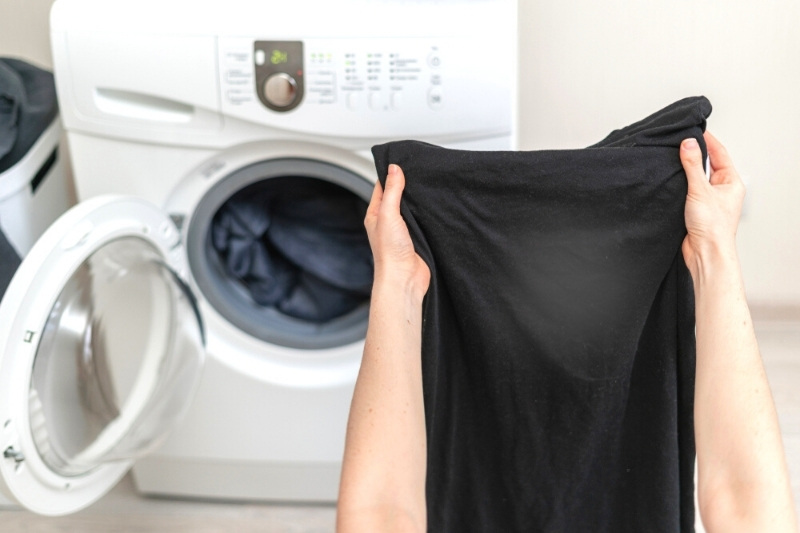
If you’re not keen on the methods above, you can always purchase a specialised dyeing product that you can put straight into the washing machine to dye your black clothes.
Dylon Wash & Dye Fabric Dye For Clothes
Dylon Wash & Dye Fabric Dye For Clothes is simple to use because you add the powder from the sachet straight into the washing machine, then you add your garments and start the washing machine. It’s a very inexpensive way to dye laundry, and it’s a lot less fuss and mess for you to endure!
All you need to do is make sure the washing machine runs a cotton cycle at 40℃ with the dye inside, and once the initial cycle is done you just need to run the same cycle again but with detergent.
Of course, to get the best results you need to adhere to what it says on the packaging. Namely, you can’t clean every single faded item at once because there’s a weight limit, and the solution might not work on every material.
Just make sure you wash your washing machine before you pop your next load of laundry in! Otherwise, you could end up with a whole load of dyed clothes.
How to Keep Black Clothes from Fading
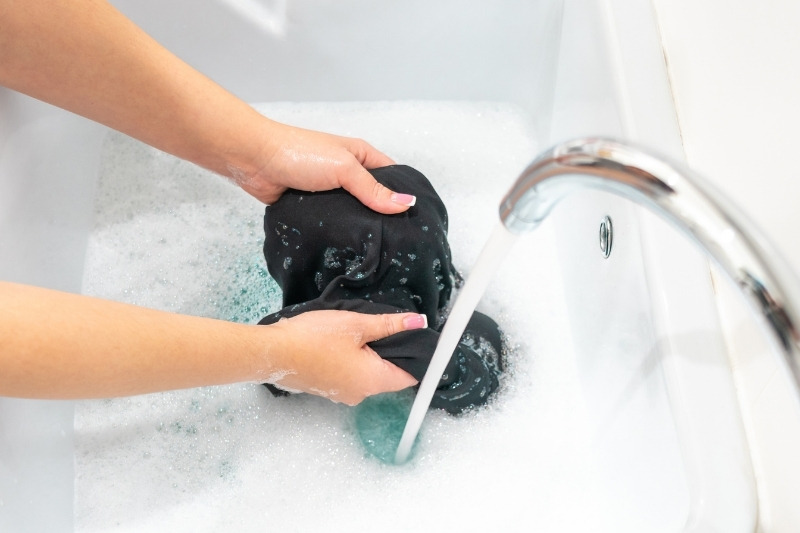
It’s inevitable that black clothes will fade eventually, but you can control how quickly the colour drains from your items.
Follow the tips below to keep your clothes in colour for longer:
- Only wash black clothes when you really need to – continuously over-washing the items will cause them to fade quicker.
- Sort your laundry piles out before washing them, so you wash dark colours together.
- Don’t be afraid to hand wash your black clothes as this slower, gentler process may help to keep the colour for longer.
- Turn black clothes inside out before laundering them.
- Gentle cycles are ideal when washing black clothes.
- Cold water washes are better for your dark/black clothes.
- Choose your detergent wisely – pick a detergent that matches the colour you’re working with, so it’ll help to enhance the colour instead of fading it. Check out our list of the best laundry detergents for coloured clothes.
- Don’t go over-the-top with laundry detergent – excess laundry cleaner can lead to more problems.
- Air dry black clothes as much as possible – the heat from a tumble dryer can sometimes encourage fading to occur.
- If your black clothes aren’t really dirty or stained, just air them and wear them again.

Bethan has a passion for exploring, reading, cooking and gardening! When she’s not creating culinary delights for her family, she’s concocting potions to keep her house clean!






